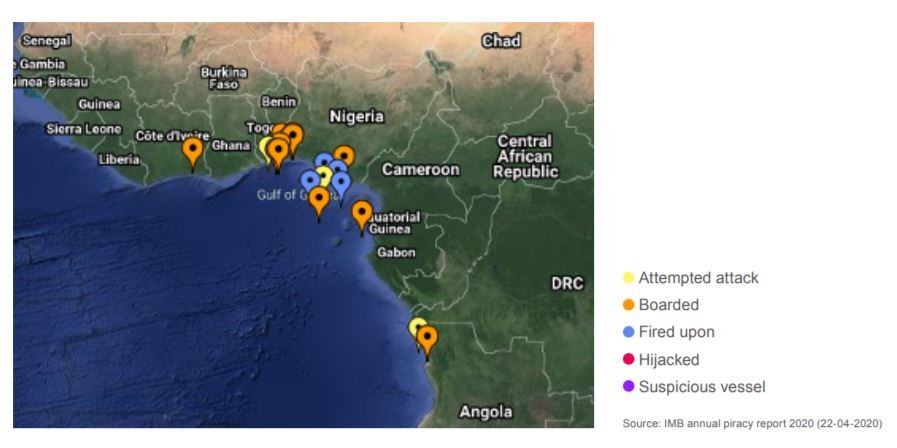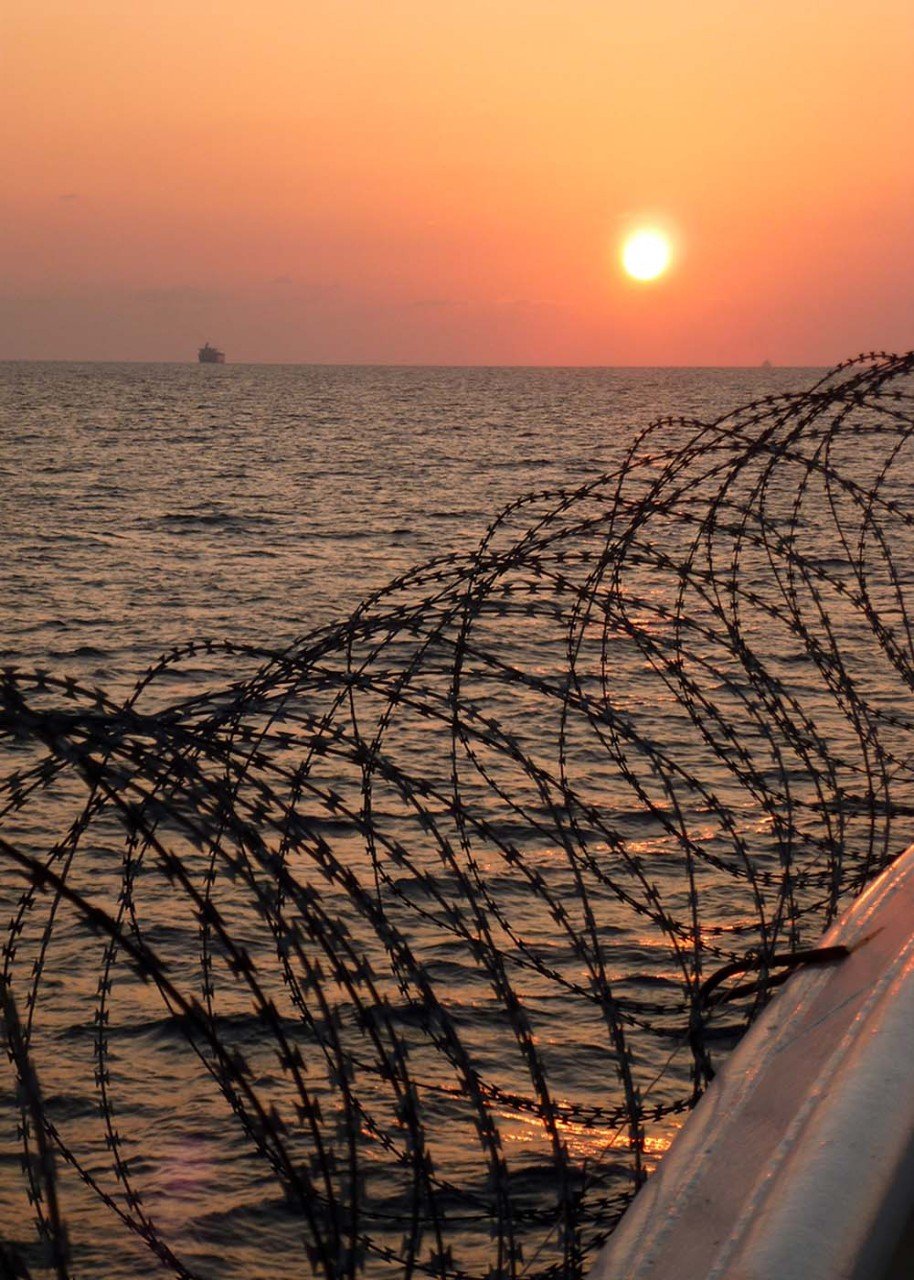Gulf of Guinea
The issue of piracy in the Gulf of Guinea is significantly different from, for example, the Horn of Africa, where most attacks take place in international waters where vessels can be protected by the international community. Within in the Gulf of Guinea however, many attacks occur near the coast and the responsibility to deal with an act of piracy within territorial waters rests with the coastal state.
National laws that govern maritime operations within the region are often deliberately opaque, disguising a lack of enforcement capacity. Corruption, weak governance, and lack of knowledge and resources make it difficult for local authorities to effectively get a grip on the threat of piracy.
Until a couple of years ago cargo theft seemed to be the main driver for piracy, but nowadays we are seeing a shift towards violent kidnapping of crew members with the objective to demand a ransom. The kidnapped crew members are consequently taken deep into the jungle where they are held hostage for months until ransom is paid. The conditions in the camps are severe, resulting in sickness or sometimes even death.
The number of kidnapped crew in the Gulf of Guinea increased by more than 50% from 78 in 2018 to 121 in 2019. In the first three months of 2020, the International Maritime Bureau Piracy Reporting Centre (IMB PRC) has already reported 47 attacks off Togo, Benin, Nigeria, Cameroon and Equatorial Guinea. Of these attacks, 37 ships were boarded by pirates.

Source: IMB annual piracy report 2020 (22-04-2020)
Precautionary measures
MS Amlin advises ship operators, masters and mariners to remain vigilant and stay cautious when operating in the Gulf of Guinea. As the subject is far too extensive to be covered in full within this circular, we recommend following and implementing the Best Management Practices for West Africa (BMPWA), which aim to help ships plan their voyage and to detect, avoid and report attacks. These can be found here.
In summary, the following precautionary measures should be taken.
Voyage planning and risk assessment
It is essential that a detailed security assessment is completed before each voyage to or within the region. A security assessment should include at least:
- The ship’s characteristics/vulnerabilities/inherent capabilities to withstand the threat.
- The ship’s and company’s procedures (drills, watch rosters, chain of command, decision making processes etc.).
- Availability of Secure Anchorage Areas (SAA), Security Escort Vessels (SEV) and co-operation with military.
Crew training
Crew members should be made aware of the threat, risks and consequences of the voyage in any risk area. Before departure, the crew should be briefed on how to implement and use the vessel protection measures. In addition, regular drills should be conducted as training in a safe environment gives crew members valuable hands on experience and the confidence needed in a real emergency.
Information security
In order to prevent information about the vessel, her location, cargo and crew from falling into the wrong hands, communication with external parties should be kept to a minimum. The crew should be reminded of the dangers of posting voyage related information on social media.
Vessel protection measures
The BMP-WA contain very detailed guidance on vessel protection measures against attacks. It is recommended that the following measures are implemented or installed on board the vessel:
- A proper lookout can help to identify any threats at an early stage, allowing the crew to deploy other defences in good time.
- Physical barriers, such as razor wire, which prevents persons from boarding the vessel.
- Water or foam spray, which delays people in their attempt to board the vessel.
- Enhanced bridge protection, such as bars, steel plates and blast resistant film on windows, which reduces the risk of injury to the crew due to fragmentation.
- Citadel and safe muster points for the crew
Privately armed security personnel
The last decade demonstrated that the use of Privately Contracted Armed Security Personnel (PCASP) on board vessels has proven to be an effective measure in protecting the safety of seafarers and deferring attacks from pirates in high risk areas. Nevertheless, the decision to deploy PCASP’s should not be treated lightly and will be guided by certain requirements.
Unlike the Somalian pirate attacks in the Indian Ocean, the attacks in the Gulf of Guinea often take place on vessels entering or leaving ports, or at anchor within the territorial waters. National laws of these coastal states do not permit foreign security guards to carry firearms on board merchant vessels. Therefore, shipowners must rely on local security force, for example the local navy forces. If a shipowner wishes to have armed guards on board his vessel in an area which does not allow PCASP, all non-local armed guards must disembark the vessel and be replaced with local security personnel when the vessel is entering territorial waters. To make use of such local security guards, a shipowner can either rely on a local agent with direct links to the military or police within that country, or engage the services of an intermediary.
The carriage of firearms is a complex legal issue and is still prohibited by some flag states, although a number of flag states are in the process of amending their laws in order to allow the practice of PCASP on board vessels. MS Amlin neither dismisses nor promotes the use of services of PCASP, but would rather emphasise that the decision whether to resort to the services of such companies lies solely with the shipowner.
Accordingly, we recommend shipowners to consult their flag states when considering the services of PCASP, as well as contacting the coastal states of the territorial waters to be entered before embarking on the voyage.

Image source: Shutterstock
Contracts and clauses
In order to protect the contractual position of shipowners with regards to voyages going through or to a high risk area, we advise incorporating specific “piracy clauses” in charter parties.
BIMCO has created specialist Piracy Clauses for time charter parties, consecutive voyage charters/COAs, and single voyage charters. These clauses allow shipowners to deviate from the contractual voyage, as they are not obliged to continue to or through any port, place, area or zone which, in the reasonable judgment of the master/ owner, is dangerous due to any actual, threatened or reported piracy or violent robbery. In the event that the vessel is at a location that meanwhile becomes dangerous, the vessel shall be at liberty to leave it.
Where Privately Contracted Armed Security Personnel are employed on board a vessel, we recommend the use of contracts recognised by the industry, such as the GUARDCON, which can be found on the website of BIMCO via this link or requested from our Client Services Desk.
Useful websites
More information about piracy in the Gulf of Guinea can be found on the following websites.
- Privately armed security personnel on the website of the IMO
- Maritime Global Security
- Best Management Practices West Africa (BMP-WA) can be found here
- EU Maritime Security Factsheet: The Gulf of Guinea
- IMO – code of conduct against illicit maritime activity can be found on their website
- Maritime Domain Awareness for Trade-Gulf of Guinea (MDAT-GoG) can be found here
- International Maritime Piracy Reporting Center
- Gulf of Guinea Inter-Regional Network (GoGIN)
- Global Counter Piracy Guidance for Companies, Masters and Seafarers (GCPG)
- BIMCO
This information is meant for guidance only. Should you require more information or assistance, please feel free to contact our Client Services Desk: ClientServicesDesk@msamlin.com
